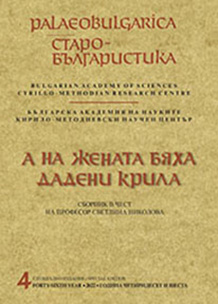Киевские переводчики с древнееврейского языка на руську мову (вторая половина XV в.) как интерпретаторы Пространного жития Кирилла Философа
Kievan Translators from Hebrew into Ruthenian (Second Half of the 15th Century) as Interpreters of the Long Vita of Cyril the Philosopher
Author(s): Sergejus TemčinasSubject(s): Language studies, Language and Literature Studies
Published by: Кирило-Методиевски научен център при Българска академия на науките
Keywords: Vita Constantini; Maimonides’ “Logical terminology”; translations from Hebrew into Ruthenian; Codex Suprasliensis; Aristotle’s “Organon”; Kiev; Jewish-Slavic relations; literary reception.
Summary/Abstract: The article focuses on the medieval literary reception of two fragments of the Long Vita of Cyril the Philosopher (chapters 4 and 8), concerning the education and scientific activities of the enlightener of the Slavs. It is reflected in a small text, which is found in two East Slavic manuscript copies of the Old Bulgarian Codex Suprasliensis, which are dated to the 16th century and go back to a common (probably Kievan) archetype not prior to 1489. The additional text contains lists of sciences, the reading of which was included in the educational program of several Jewish and Greek intellectuals (their names are explicitly indicated), including Cyril the Philosopher. The information of the Long Vita that on his way to Khazaria, Cyril the Philosopher translated a Hebrew grammar in eight parts, is conveyed here differently – this text he dealt with is called the eight books of logic. The author demonstrates that a key to such an interpretation is Maimonides’ treatise Logical Terminology translated into Ruthenian, and by the eight books of logic is meant the eight-book Aristotle’s Organon (e.g. expanded with his Rhetorics and Poetics). Such an interpretation could only arise among Jewish bookmen who, in collaboration with East Slavic scribes, were engaged in translating Hebrew scholarly treatises into Ruthenian in Kiev in the second half of the 15th century.
Journal: PALAEOBULGARICA / СТАРОБЪЛГАРИСТИКА
- Issue Year: 2022
- Issue No: 4 Special
- Page Range: 241-253
- Page Count: 13
- Language: Russian
- Content File-PDF

